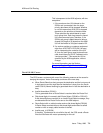
ASAI and Call Routing
7-2 Issue 7 May 1998
Route
This capability allows the ECS to request routing information from the adjunct.
The adjunct provides it based upon incoming call information. This feature may be
used independently of or in conjunction with call monitoring (Event Notification
turned on).
Starting with G3V3, the ASAI-Requested Digit Collection feature gives an adjunct
the ability to request that a DTMF tone detector (TN744) be connected to detect
user-entered digits. The request is made via an option of the Route Select
message. The digits collected as a result of this feature are passed to ASAI
monitoring and/or controlling adjuncts for action. The ECS handles these digits
like dial-ahead digits. The digits are collected while the call is not in vector
processing; they are sent to an ASAI adjunct, and/or they may be used by Call
Prompting features.
Information Flow
The ECS sends a route request to the adjunct. The adjunct does not return an
acknowledgment to the ECS upon receipt of the routing request, but rather the
adjunct sends a Route Select capability when a route is available.
Route Parameters
calling party
number/billing number
(CPN/BN)
■ [mandatory] For incoming call over PRI facilities —
“calling number” from the ISDN SETUP message
1
.
■ For incoming calls over non-PRI facilities, the
calling party number is generally not provided. In
this case, the Trunk Group and member numbers
are provided instead.
■ For calls originated at a bridged call appearance —
the principal’s extension
■ For incoming DCS calls, if the DCS calling party
information is available to the ECS (if a station with
a display gets it), this information is also made
available to ASAI.
■ For incoming calls over R2-MFC facilities, if calling
party information is provided, it is collected and
passed on to the adjunct. Otherwise, the calling
party information is provided as the default.


















